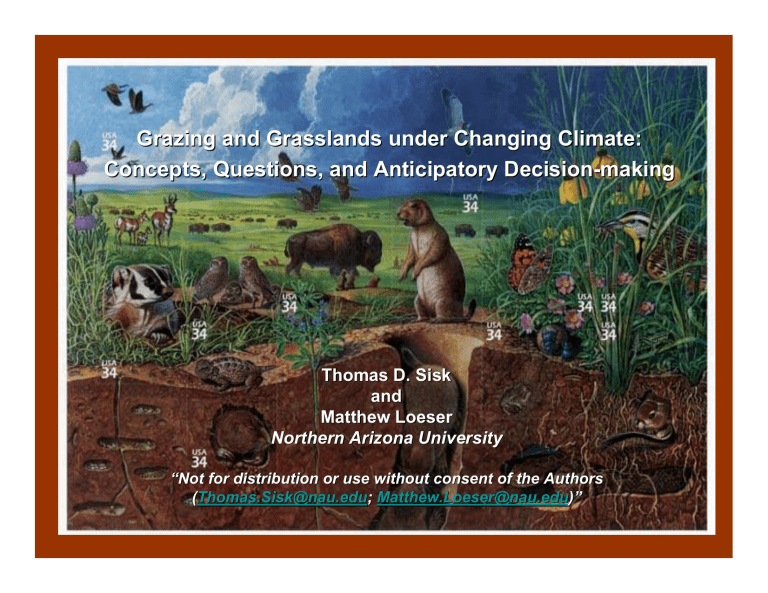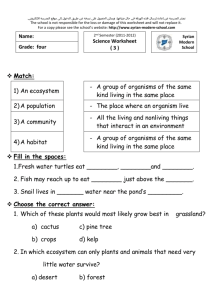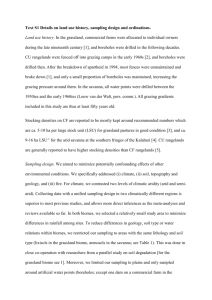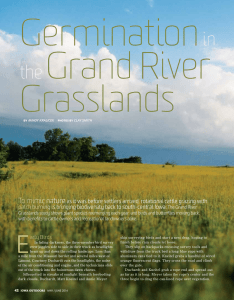Grazing and Grasslands under Changing Climate: Concepts, Questions, and Anticipatory Decision - making
advertisement

Grazing and Grasslands under Changing Climate: Concepts, Questions, and Anticipatory Decision-making Thomas D. Sisk and Matthew Loeser Northern Arizona University “Not for distribution or use without consent of the Authors (Thomas.Sisk@nau.edu; Matthew.Loeser@nau.edu)” (Walker 2002) Flagstaff Globe Tucson (Walker 2002) 3 Properties of Grassland Plant Communities High turnover of aboveground plant organs Location of meristems near the soil surface Large fraction of biomass and activity belowground The results of selection pressures from drought, fire, and herbivores Selection Pressures: Drought, Fire, Herbivores FREQUENCY GRAZING ? FIRE DROUGHT DRY HUMID Climate Variation in Grasslands (Knapp and Smith 2001) Climate / Grazing Interactions CANOPY COVER (ABSOLUTE %) 90% TOTAL GRASS & FORB CATTLE REMOVAL MODERATE INTENSITY VERY HIGH IMPACT 80% 70% 60% 50% 40% 30% 20% 10% 0% 2001 2002 2003 (Loeser, unpubl. Data) Variability in Grassland Productivity (Knapp and Smith 2001) What are the thresholds that exceed the resilience (evolutionary history) of grasslands? Thresholds, the Simple Version Ecosystem State ENVIRONMENTAL CONDITIONS Ecosystem State A B C Thresholds, the Simple Version Ecosystem State ENVIRONMENTAL CONDITIONS Ecosystem State A B C Threshold (# of years) frequency Thresholds and Vulnerability Vulnerable Conditions Vulnerable Conditions Soil Moisture Threshold conditions: Drought Threshold conditions: Unstable Equilibria Compaction/Erosion Climate Change: One Hypothesis Vulnerable Conditions (# of years) frequency Vulnerable Conditions Soil Moisture (# of years) frequency An Alternative Hypothesis: Vulnerable Conditions Vulnerable Conditions Soil Moisture Ecological & Social Dynamics Under Climate Change Meeting management challenges Grassland Ecosystem Conditions via monitoring Grazing Social System Mgmt Decisions Disturbance remains within NRV via “smart” decisions Scenarios of Ecological & Social Dynamics Under Climate Change Grazing Under Drought Conditions: Grassland Ecosystem Palatable perennials recover Grazing Social System Cattle numbers reduced “Just in time” Scenario A More Likely Scenario… Grazing Under Drought Conditions: Grassland Ecosystem Grazing Social System Wait, hope, pray Palatable perennials crash Cattle numbers reduced Threshold crossed = degradation Annual grassland; shrub encroachment; barren land; etc. “Too late” Scenario Progressive Scenario Under Drought Conditions: Cattle moved Grassland Ecosystem Degradation Avoided or Minimized Grass Bank “Datadriven” Grazing Social System Anticipatory decision-making Requires monitoring and an adaptive decision framework… Smarter Decision-making Making management decisions in the context of uncertain conditions and system responses Decision Theory Framework Information Decision True State (unknown) Stressed Reduce Grazing Utility 0.75 (p) Not stressed 0.50 (1-p) Monitoring Signal Stressed 0.10 suggests drought (p) Status quo Not stressed (1-p) 1.00 Decision Theory Framework Information Decision True State (unknown) Stressed Reduce Grazing Utility 0.75 (p) Not stressed 0.50 (1-p) Monitoring Signal Stressed 0.10 (p) Status quo Not stressed (1-p) 1.00 Keys Steps: Anticipating Change Understanding Thresholds Acknowledging Ecological-Social Linkages Appropriate Monitoring Making Better Decisions Under Uncertainty Questions – 1) Grass and Grasslands • How does the adaptation of grassland plants prepare them for environmental variability? • Are grasslands plants more or less capable of coping with climate change? • Grassland communities / ecosystems? • What leads to vulnerability in grasslands? • Ecological resiliency vs. resistance to change… – What are the trade-offs? • What is the relationship between the frequencies of drought and fire? Questions – 2) “Socio-ecology” • Almost all grasslands are directly coupled with human systems; implications? • Social / ecological responses are complex; what are the feedbacks? • What are the most likely drivers of catastrophic shifts in grassland composition, organization, and function? Questions – 3) What’s Important? What is the important science to be done? • Studies of effects of cattle removal? • Experiments on response to various climate conditions? Grazing intensities? Interactions? • Development of informative and practical monitoring plans for early warning? • Decision theory to better integrate social and ecological system dynamics?






